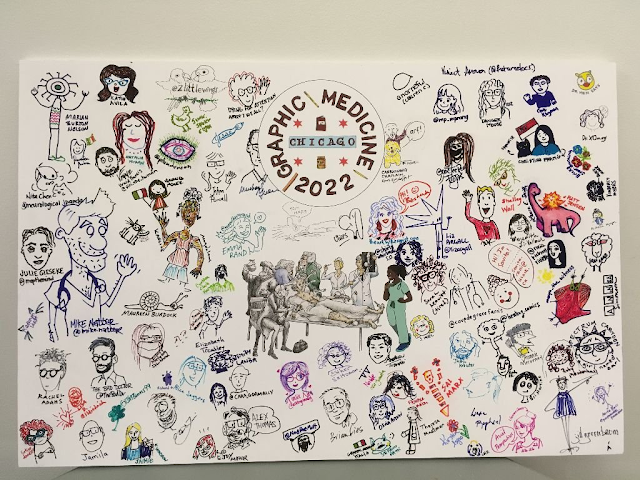Here's a photo dump from the 2022 Graphic Medicine Conference in Chicago. I haven't made it to the conference every year, but I've been to many since I was invited to the first in London in 2010. Since then, the field has grown enormously--to the point that we OG GMers joke that we don't even know everybody doing it anymore--and the level of academic and creative work being done is impressive.
These are extraordinary events for me. I love 'em. The talks and panels are always interesting. I took two hands-on workshops--one by Mita Mahato on using color expressively and another by Sarah Leavitt on grief--that will stick with me.
With all conferences, all the best stuff happens in the hallways between formal events. And immodestly, the number of people who told me they got into graphic medicine because of Mom's Cancer, including a family who started a scholarship in the name of their late son, was large enough to leave me blushing. When you tell a story, you never know the splash and ripples it'll make.
 |
| My friend MK Czerwiec, "Comic Nurse," one of the originators of graphic medicine--not just the conferences, but the entire field. She wrote her own graphic novel, "Taking Turns," on her experience in a Chicago AIDS ward, and edited the very well-received anthology "Menopause." Also, MK is not wearing a tiny sideways cap, I just timed our selfie poorly. |
 |
| Physician Michael Green, British physician and graphic novelist Ian Williams, and a guy without an MD. Ian, with MK, is the other originator of graphic medicine and the inventor of the term. Not surprisingly for a conference with a lot of doctors and nurses, the event is extremely COVID-conscious. Masks always on indoors, and often on outdoors as well. |
 |
| Four of my favorite people on the planet, truly: artist, author and teacher Mita Mahato; professor Juliet McMullin; graphic novelist and teacher Sarah Leavitt; and public health professional Meredith Li-Vollmer. Together they represent a good cross-section of the types of people and expertise that go to a graphic medicine conference. |
 |
| The conference is hosted by the University of Chicago, where the library has a very large exhibition dedicated to the history of graphic medicine, of which my work is a small part. In the display case is one of three surviving pages of original art from my book "Mom's Cancer," which I gifted to MK several years ago. It couldn't have a better home. |
 |
| What a typical panel looks like sitting in the middle of the audience. Dr. Theresa Maatman is in the foreground, and I wish I remembered the name of the guy behind her because I had a couple of nice chats with him, but I don't. Sorry. |
 |
| The face of conferencing in the modern era. Many, many people participated via Zoom, which introduced some tech problems, especially when presentations had to be shared and so forth. There were some hiccups but on the whole I think it went well. But I really took this photo because the guy at lower left used a page from my book as his digital background, and I was honored. |
 |
| This large foam-core board was left out all weekend for participants to draw their self-portraits or avatars. I'm at bottom center. |
 |
| After the last event on Saturday, a small group of us went out to dinner. Clockwise from left: Professor Susan Squier, Dr. Ian Williams, Harvard medical librarian Matthew Noe, professor Shelley Wall, me, and Dr. Michael Green. I include honorifics not to impress but to indicate the breadth of experience and interests people bring to these conferences. It's the best thing about them. Also, most of those people have authored or co-authored books. Photo by Susan's partner Gowen Roper. |
 |
| After the dinner, we joined others at an outdoor patio for refreshments and happy conversation. A nice wind-down. |
 |
| I made a little pilgrimage to this statue commemorating the University of Chicago's role in the Nuclear Era. Near this spot in 1942, Enrico Fermi and his team carried out what was surely one of the most reckless and dangerous scientific experiments in history by piling a heap of uranium-laced graphite bricks under the stands of a football stadium, making the world's first nuclear reactor and potential dirty bomb that could have wiped out half of Chicago. It didn't, so 25 years later they built a monument to it. |
 |
| I always say I know I'm back east when I see brick buildings. We don't have brick buildings in California. Ours fell down in 1906. I get the willies walking into them. |
#graphmed2022











No comments:
Post a Comment